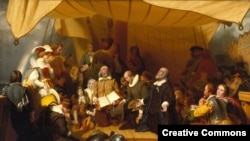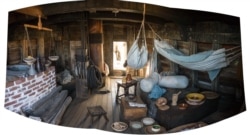As the Mayflower set off from the English port of Plymouth 400 years ago this month, the 102 passengers and crew of nearly 30 were cheered by fair weather and "a prosperous wind." But the departure belied what they would encounter on a 3,000-mile journey across a turbulent ocean.
Their transatlantic passage would take ten grueling weeks of seasickness and danger. They knew it would be harsh, but nothing could have prepared them for the terror of the almost continuous assaults from northeasterly storms and westerly gales that hardly eased for half of their crossing.
Mountainous waves crashed down on the deck. For several days the crew did not dare hoist the sails for fear the Mayflower would be fatally de-masted. The ship, old and leaky, was little more than 100 feet long and had not been built with the Atlantic in mind but had been designed for trade off the coasts of western Europe.
Only one passenger, Stephen Hopkins, knew the peril firsthand of an Atlantic crossing. He had been shipwrecked in Bermuda in 1609.
Before the coronavirus pandemic emerged this year major events on both sides of the Atlantic had been arranged to mark the 400th anniversary of the historic voyage of the Mayflower, a key moment in the history of the United States. Many have been canceled.
Nonetheless, in towns in Massachusetts, England and the Netherlands English events are still taking place and more so in the coming weeks and months. Many have been moved online, to record, celebrate and understand what drove the 102 to make the storm-wracked passage.
Motivated by religion
Around half of the passengers were English Protestant Separatists, who had broken from the Church of England and were self-described "Saints." They had traveled from Holland, where they had fled and settled for more than a decade. They now hoped to establish a church in the New World. Their origins were in rural towns and villages of the English counties of Nottinghamshire, Yorkshire and Lincolnshire.
None were swashbuckling adventurers. They were artisans and farmers. But they believed America had been chosen for them by God. They "believed they had a covenant like the Jewish people of old," according to author and historian Rebecca Fraser. "America was the new Promised Land."
"It was a stunningly audacious proposition," historian Nathaniel Philbrick noted in his book "Mayflower: A Story of Courage, Community, and War." There had been several attempts to establish English settlements before the Mayflower, but all had failed with the exception of Jamestown in Virginia, which was founded in 1607.
And Jamestown "could hardly be counted a success," Philbrick observes. "During the first year, 70 of 108 settlers had died." Replenished with more settlers, the following winter saw 440 out of 500 Jamestown settlers buried in just six months in what came to be known as "the starving time."
The Saints — it was only in the eighteenth century they were renamed Pilgrim Fathers — weren't alone on the journey. A group of entrepreneurs in London known as the Merchant Adventures, who helped back the venture, recruited others known as "Strangers," to help fund the passage and to make up numbers. Some are believed to have been sympathetic to the Saints' religious goals, but most were not.
Most Strangers likely saw the voyage as a commercial opportunity. Among them shoemaker William Mullins, from the market town of Dorking in southern England, who took along stocks of shoes and boots. He was accompanied by his wife, Alice and four of their children, including Priscilla, a teenager, and Joseph, an infant.
Difficulties
They like all the passengers — Saints and Strangers alike — were cooped up in the so-called between-decks — a space little more than 75 feet long and under five-feet high. Three were pregnant — one of whom gave birth to a son, who was named Oceanus. Delay in setting off — an accompanying ship had to be abandoned, possibly due to sabotage from Dutch rivals who were planning their own colony — meant they missed the planned departure date of July, when the weather would have been easier.
Most of what we know of the journey comes from the journal of William Bradford, one of the Saints' leaders, who came from a prosperous family of farmers in Yorkshire. But he provided just a few paragraphs in his journal "Of Plymouth Plantation" on the voyage itself, devoting most to the planning of the trip and the establishment of the colony at Cape Cod.
We know from Bradford of the physical and psychological torment of the bruising passage, and of the appalling seasickness they suffered. And of how some of the hardened sailors mocked the passengers, one in particular said, "He hoped to help cast half of them overboard before they came to their journey's end."
Bradford delighted in recording "it pleased God, before they came half seas over, to smite this young man with a grievous disease, of which he died in a desperate manner, and so was himself the first that was thrown overboard."
He added: "it was an astonishment to all his fellows for they noted it to be the just hand of God upon him." One storm washed a passenger, John Howland, overboard, but he managed to grab a rope as he plunged over, and was heaved back on board. But the only fatality, surprisingly, was the sailor.
There was dissension between the Saints and some of the "profane" Strangers, who threatened mutiny after the ship had been driven off course from its planned destination of northern Virginia. Before they disembarked at Cape Cod, in what would become Massachusetts, and to avoid a rebellion, the two groups reached an accord, later known as the Mayflower Compact, which set the rules for the self-governance for the new colony.
In essence, the pact agreed for the colony to be ruled through majority agreement.
"Being thus arrived in a good harbor and brought safe to land, they fell upon their knees and blessed the God of heaven, who had brought them over the vast and furious ocean, and delivered them from all the perils and miseries thereof, again to set their feet on the firm and stable earth, their proper element," wrote Bradford, who would become, the second Governor of the Plymouth Colony.







